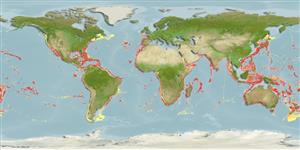>
Scombriformes (Mackerels) >
Gempylidae (Snake mackerels)
Etymology: Lepidocybium: Greek, lepis = scale + Greek, kybion, -ou = tunna (Ref. 45335).
Environment: milieu / climate zone / depth range / distribution range
Écologie
marin benthopélagique; océanodrome (Ref. 51243); profondeur 200 - 1100 m (Ref. 44037). Deep-water; 50°N - 56°S, 180°W - 180°E (Ref. 6181)
Tropical and temperate seas of the World, but probably not occurring in the northern Indian Ocean. Northwest Atlantic: Canada (Ref. 5951). Eastern Atlantic: known from 13°N off Guinea to Lobutu, Angola (Ref. 10816).
Taille / Poids / Âge
Maturity: Lm ? range ? - ? cm
Max length : 200 cm SL mâle / non sexé; (Ref. 6181); common length : 150 cm SL mâle / non sexé; (Ref. 6181); poids max. publié: 45.0 kg (Ref. 3403)
Épines dorsales (Total) : 8 - 9; Rayons mous dorsaux (Total) : 16 - 18; Épines anales: 1 - 2; Rayons mous anaux: 12 - 14; Vertèbres: 31. Body almost uniformly dark brown, becoming almost black with age. Pelvic fins well developed, with I spine and 5 soft rays (Ref. 9784). Prominent lateral keel on caudal peduncle, flanked by smaller accessory keels above and below (Ref. 26938).
Occurs mainly over the continental slope, down to 200 m and more (Ref. 6181). Migrates upward at night (Ref. 6181). Feeds on squid, crustaceans and a wide variety of fishes (Ref. 6181). Flesh oily and may have purgative properties (Ref. 9784). Sometimes caught by tuna long-liners (Ref. 26938). Marketed frozen and as fish cakes in Japan (Ref. 9302).
Life cycle and mating behavior
Maturité | Reproduction | Frai | Œufs | Fécondité | Larves
Nakamura, I. and N.V. Parin, 1993. FAO Species Catalogue. Vol. 15. Snake mackerels and cutlassfishes of the world (families Gempylidae and Trichiuridae). An annotated and illustrated catalogue of the snake mackerels, snoeks, escolars, gemfishes, sackfishes, domine, oilfish, cutlassfishes,. scabbardfishes, hairtails, and frostfishes known to date. FAO Fish. Synop. 125(15):136 p. (Ref. 6181)
Statut dans la liste rouge de l'IUCN (Ref. 130435: Version 2024-2)
Menace pour l'homme
Harmless
Utilisations par l'homme
Pêcheries: intérêt commercial mineur; pêche sportive: oui
Outils
Articles particuliers
Télécharger en XML
Sources Internet
Estimates based on models
Preferred temperature (Ref.
123201): 7 - 14.4, mean 9.9 °C (based on 642 cells).
Phylogenetic diversity index (Ref.
82804): PD
50 = 1.0000 [Uniqueness, from 0.5 = low to 2.0 = high].
Bayesian length-weight: a=0.01202 (0.00608 - 0.02377), b=2.98 (2.80 - 3.16), in cm total length, based on LWR estimates for this species & (Sub)family-body (Ref.
93245).
Niveau trophique (Ref.
69278): 4.3 ±0.67 se; based on food items.
Résilience (Ref.
120179): Faible, temps minimum de doublement de population : 4,5 à 14 années (Assuming tm=4-5).
Fishing Vulnerability (Ref.
59153): Very high vulnerability (90 of 100).
Climate Vulnerability (Ref.
125649): Moderate vulnerability (39 of 100).
Nutrients (Ref.
124155): Calcium = 7.33 [3.81, 15.92] mg/100g; Iron = 0.279 [0.128, 0.578] mg/100g; Protein = 17.1 [14.9, 19.0] %; Omega3 = 0.33 [0.19, 0.60] g/100g; Selenium = 29.2 [12.6, 64.6] μg/100g; VitaminA = 11.8 [2.8, 50.1] μg/100g; Zinc = 0.25 [0.17, 0.37] mg/100g (wet weight);
